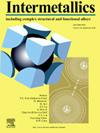Effect of multi‒directional forging on the evolution of intermetallic precipitates and mechanical properties in novel light refractory high-entropy alloys
IF 4.3
2区 材料科学
Q2 CHEMISTRY, PHYSICAL
引用次数: 0
Abstract
The mechanical properties of refractory high‒entropy alloys (RHEAs) are influenced by the types and concentrations of the constituent elements and significantly influenced by the precipitation behavior. In this study, the Al20Nb14Ti34Zr29Cr4 RHEA was designed to investigate the impact of precipitation on its microstructure and properties. The density of the alloy was only 5.53 g/cm3. Significant amounts of the Al3Zr5 phase and C14 Laves phase precipitated following prolonged annealing treatment. The evolution of the microstructure of the alloy was investigated through multi‒directional forging at temperatures of 1000 °C and 1200 °C. High‒temperature forging causes the dissolution of the Al3Zr5 phase, and greater dissolution occurs at elevated temperatures. Additionally, during high‒temperature forging, dissolution and subsequent reprecipitation of the C14 Laves phase occur. Lower forging temperatures promote increased reprecipitation of the C14 Laves phase. The alloy forged at 1000 °C exhibited an exceptional yield strength of 1870.1 MPa, accompanied by a specific yield strength of 338.2 N∙m/kg and a compressive limit deformation of 20.9 %. This remarkable performance can be attributed to the changes in the shape size and distribution of the precipitated phase during the forging process at 1000 °C, as well as the grain refinement caused by recrystallization. These factors work together to improve the strength and plasticity of the alloy.
多向锻造对新型轻质难熔高熵合金金属间析出物演化及力学性能的影响
耐火高熵合金(RHEAs)的力学性能受组成元素类型和浓度的影响,并受析出行为的显著影响。本研究设计了Al20Nb14Ti34Zr29Cr4 RHEA,研究了析出对其组织和性能的影响。合金密度仅为5.53 g/cm3。长时间退火后析出大量的Al3Zr5相和C14 Laves相。通过1000℃和1200℃的多向锻造,研究了合金组织的演变。高温锻造导致Al3Zr5相的溶解,在高温下溶解更大。此外,在高温锻造过程中,C14 Laves相发生溶解和随后的再析出。较低的锻造温度促进了C14 Laves相的再析出。该合金在1000℃锻造时屈服强度达到1870.1 MPa,比屈服强度为338.2 N∙m/kg,压缩极限变形为20.9%。这种显著的性能可归因于1000℃锻造过程中析出相的形状尺寸和分布的变化,以及再结晶引起的晶粒细化。这些因素共同作用,提高了合金的强度和塑性。
本文章由计算机程序翻译,如有差异,请以英文原文为准。
求助全文
约1分钟内获得全文
求助全文
来源期刊

Intermetallics
工程技术-材料科学:综合
CiteScore
7.80
自引率
9.10%
发文量
291
审稿时长
37 days
期刊介绍:
This journal is a platform for publishing innovative research and overviews for advancing our understanding of the structure, property, and functionality of complex metallic alloys, including intermetallics, metallic glasses, and high entropy alloys.
The journal reports the science and engineering of metallic materials in the following aspects:
Theories and experiments which address the relationship between property and structure in all length scales.
Physical modeling and numerical simulations which provide a comprehensive understanding of experimental observations.
Stimulated methodologies to characterize the structure and chemistry of materials that correlate the properties.
Technological applications resulting from the understanding of property-structure relationship in materials.
Novel and cutting-edge results warranting rapid communication.
The journal also publishes special issues on selected topics and overviews by invitation only.
 求助内容:
求助内容: 应助结果提醒方式:
应助结果提醒方式:


